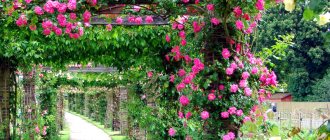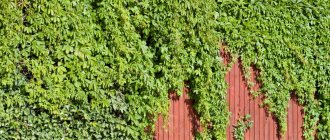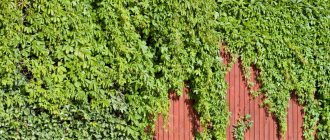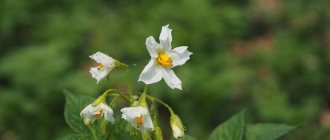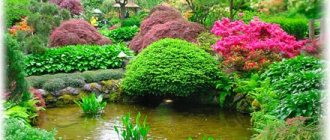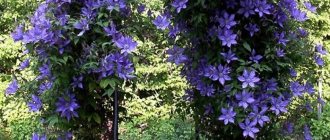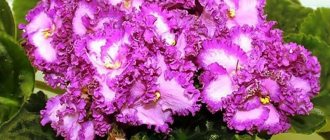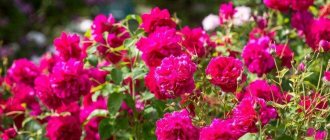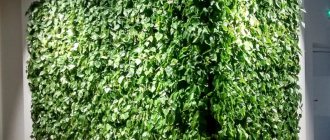Perennial vines with decorative leaves
To choose climbing perennials, you should know that they are divided into several types: creeping (for landscaping horizontal areas), climbing (with suckers on the stems) and clinging to supports.
If you want to create a hedge, then choose perennial climbing plants with decorative carved leaves or leaves of an unusual, bizarre shape.
Typically, these crops are not afraid of frost, drought-resistant, and do not require special care. Most often they are used for landscaping a fence, especially if the fence spoils the appearance of the site, as well as any garden and outbuildings.
Amur grapes
Amur grape is an unpretentious plant; if planted near a fence or unsightly outbuilding, it will quickly fill the space and decorate the object. The length of an adult grape is 20 meters.
From its name we can conclude that the plant is not afraid of frost. Indeed, Amur grapes have the highest frost resistance among grape species.
The plant appeared before the Ice Age, and then successfully took root in harsh conditions, so it is not afraid of any frost.
By planting a vine along the fence, you will soon have a magnificent hedge, and even enjoy delicious fruits. This grape variety can be safely shaped as you wish; it is not afraid of pruning. Even after shearing, it will be strewn with bunches of berries.
Euonymus rotundifolia
One of the most beautiful climbing plants can be called rotundifolia. The liana can be used to decorate high fences, pergolas, gazebos, and trellises. The bush quickly climbs to any height using flexible lashes.
But wood pliers are dangerous to other plants. They can destroy any tree by tightly hugging its trunk and digging their lashes deeply into it. In his strong embrace, other trees simply die. This destroyer should not be allowed to be near a tree of any kind.
Wood pliers are unpretentious and can grow in any place, creating beautiful pictures without requiring any care. You just need to plant it somewhere separately.
Actinidia
If you have a shaded fence or wall of a house where little light penetrates, then plant actinidia. She doesn't like to be in the sun. To create original vertical compositions in the garden, actinidia is also best suited.
It can grow on any soil. And not just to grow, but to annually present the owners with delicious oblong fruits. Breeders have developed many varieties of actinidia that produce good harvests. The most generous harvest varieties are: Soroka, Prazdnichny, Slastena, Lakomka.
The fruits of this plant, similar to kiwi, are endowed with many useful vitamins and microelements.
Maiden grapes
Another type of grape is girlish grape. It will grow well wherever you find a place for it, the main thing is to prune it in a timely manner. It can take a liking to arches, walls, fences, or occupy the entire free surface of the dacha.
With its help, it is easy to landscape the most unsightly area in the garden. It is unpretentious and grows very quickly, which is what attracts gardeners.
Honeysuckle Kamchatka
Kamchatka honeysuckle is more capricious than other plants that are planted as a hedge. She does not like drafts and shaded places. Kamchatka honeysuckle bushes should be planted in sunny areas, regularly watered and fertilized.
It is valuable that this shrub is not afraid of frost and produces tasty fruits rich in vitamins C, B, P and microelements beneficial to humans.
garden ivy
Another beautiful plant that can decorate any structure is garden ivy.
If you need to cover the gazebo with a green carpet, then ivy is the most convenient plant. One of the most unpretentious climbing plants is ivy. It can grow up to 30 meters in height, so it can entwine even the highest supports.
For gazebos and pergolas, this is not only a decoration, but also a way to create a romantic, private place in the garden.
Planting should be carried out with seedlings 2-3 years old. They are planted in spring in shallow holes with organic fertilizer. In summer it must be trimmed to any shape. But before winter frosts, the ivy roots must be covered with earth, leaves, and then with a special coating.
Garden ivy is easy to care for, but prefers fertilized soil, so from time to time it needs to be fertilized, as well as watered and pruned.
Kirkazon largeleaf
Kirkazon largeleaf is capable of creating an amazing picture - neatly laid tiles. This plant can grow in any soil, but is very afraid of drafts. It is worth noting its picturesque appearance and high frost resistance.
Any arch, pergola, gazebo can be decorated with a picturesque steeplejack, and a green tunnel can be created. Flowers of unusual shape and outlandish color are striking, as well as its miraculous medicinal properties, which are widely used in folk medicine.
Encyclopedia of gardening, floriculture and landscape design
Apricot - Ornamental trees and shrubs Apricot - Fruit and berry crops Manchurian apricot - Ornamental trees and shrubs Abutilon - Indoor plants Abutilon hybrid - Indoor plants Pleasant avocado - Indoor plants Avran - Plants for ponds Avran - Herbaceous plants for open ground Avran officinalis - Herbaceous plants for open ground Agave - Indoor plants Agave americana - Indoor plants Queen Victoria Agave - Indoor plants Agapanthus - Indoor plants Agapanthus umbellata - Indoor plants Ageratum - Herbaceous plants for open ground Ageratum Houston - Herbaceous plants for open ground Ageratum mexicanis - Herbaceous plants for open ground Aglaonema - Indoor plants Aglaonema variable - Indoor plants Adam's tree - Ornamental trees and shrubs Adenium - Indoor plants Adenium thick - Indoor plants Adenium obese - Indoor plants Adiantum - Indoor plants Adiantum - Herbaceous plants for open ground Adiantum Venus hair - Indoor plants Adiantum Radde - Indoor plants Adiantum beautiful - Indoor plants Adiantum large-leaved - Indoor plants Adiantum finely pubescent - Indoor plants Adiantum tender - Indoor plants Adiantum reniform - Indoor plants Adiantum foot-shaped - Herbaceous plants for open ground Adiantum caudate - Indoor plants Adlumia - Lianas Adlumia spongiosa - Lianas Adonis - Herbaceous plants for open ground Adonis vernacular - Herbaceous plants for open ground Adromiscus - Indoor plants Adromiscus maculata - Indoor plants Azalea - Indoor plants Azalea ponticus - Ornamental trees and shrubs Azarina - Lianas of Azarina Barclay - Lianas of Azarina antirhinotsvetkovaya - Lianas of Azarina climbing - Lianas of Azarina erubescens - Azolla creepers - Plants for ponds Azolla carolina - Plants for ponds Calamus - Houseplants Calamus - Plants for ponds Calamus marsh - Plants for ponds Calamus grass - Houseplants Calamus grass - Plants for ponds Calamus dwarf - Houseplants Calamus variegated - Houseplants Calamus herbaceous — Indoor plants Calamus reed — Plants for ponds Aichrizon — Indoor plants Aichrizon domestic — Indoor plants Aichrizon prostrate — Indoor plants Aichrizon loose — Indoor plants Quince — Fruit and berry crops Quince low — Ornamental trees and shrubs Quince oblong — Fruit and berry crops Quince Japanese — Ornamental trees and shrubs Japanese quince — Ornamental trees and shrubs Akalifa — Indoor plants Akalifa Wilks — Indoor plants Akalifa rough — Indoor plants Akalifa bristly — Indoor plants Acantopanax sessile — Ornamental trees and shrubs Acantopanax sessile — Ornamental trees and shrubs Aquilegia — Herbaceous plants for open ground Aquilegia hybrid - Herbaceous plants for open ground Aquilegia vulgaris - Herbaceous plants for open ground Akka Zellova - Houseplants Akmella oleracea - Vegetable crops Aconite - Lianas Aconite - Herbaceous plants for open ground Aconite climbing - Creepers Aconite climbing - Herbaceous plants for open ground Aconite globulus - Herbaceous plants for open ground Akorus - Indoor plants Akorus - Indoor plants Actinidia - Lianas Actinidia - Fruit and berry crops Actinidia arguta - Lianas Actinidia arguta - Fruit and berry crops Actinidia arguta x Actinidia purpurea - Fruit and berry crops Actinidia hybrida - Fruit and berry crops Actinidia giralda - Fruit and berry crops Actinidia kolomikta - Lianas Actinidia kolomikta - Fruit and berry crops Actinidia polygamous - Lianas Actinidia nosata - Lianas Actinidia acute - Lianas Actinidia acute - Lianas Actinidia polygamous - Lianas Actinidia polygamous - Fruit and berry crops Actinidia polygamous rowdy — Lianas Actinidia purpurea — Fruit and berry crops Actinotus — Herbaceous plants for open ground Actinotus sunflower — Herbaceous plants for open ground Alyssum — Herbaceous plants for open ground Alyssum — Herbaceous plants for open ground Alyssum Gmelina — Herbaceous plants for open ground Alyssum montana — Herbaceous plants for open ground Alyssum marine - Herbaceous plants for open ground Alyssum rocky - Herbaceous plants for open ground Allamanda - Indoor plants Allamanda laxative - Indoor plants Allium - Herbaceous plants for open ground Alocasia - Indoor plants Alocasia Amazonis - Indoor plants Alocasia indica - Indoor plants Alocasia capularis - Indoor plants Alocasia macrorhizomatous - Indoor plants Alocasia copper-red - Indoor plants Aloe - Indoor plants Aloe arborescens - Indoor plants Aloe spinosa - Indoor plants Aloe variegated - Indoor plants Scarlet skullcap - Indoor plants Cherry plum - Ornamental trees and shrubs Cherry plum - Fruit and berry crops Alpine violet - Indoor plants Alsobia - Indoor plants Alsobia carnation - Indoor plants Alternanthera - Plants for ponds Alternanthera - Herbaceous plants for open ground Alternanthera serrata - Herbaceous plants for open ground Alternanthera sweetheart - Herbaceous plants for open ground Alternanthera sessile - Plants for reservoirs Amazon lily - Indoor plants Amaranth - Herbaceous plants for open ground Amaranth crimson - Herbaceous plants for open ground Amaranth paniculata - Herbaceous plants for open ground Vegetable amaranth - Vegetable crops Pinnate amaranth - Herbaceous plants for open ground Amaranth tricolor - Herbaceous plants for open ground Amaranth caudate - Herbaceous plants for open ground Amaryllis - Indoor plants Amaryllis belladonna - Indoor plants Amberboa musk - Herbaceous plants for open ground American water white lily - Plants for ponds American water white lily - Plants for ponds American wintergreen - Ornamental trees and shrubs American melon — Vegetable crops American yellow stock — Ornamental trees and shrubs Ammania — Plants for ponds Ammania senegalese — Plants for ponds Ammobium — Herbaceous plants for open ground Ammobium winged — Herbaceous plants for open ground Ammocallis — Indoor plants Amorpha — Ornamental trees and shrubs Amorpha shrubby — Ornamental trees and shrubs Amorphophallus - Indoor plants Amorphophallus cognac - Indoor plants Amorphophallus bulbiferous - Indoor plants Amur rose - Ornamental trees and shrubs Pineapple - Indoor plants Pineapple large-tufted - Indoor plants Pineapple bract - Indoor plants Anaphalis - Herbaceous plants for open ground Anaphalis pearl - Herbaceous plants for open ground Angelonia - Herbaceous plants for open ground Angelonia angustifolia - Herbaceous plants for open ground Angel trumpets - Indoor plants English bulbous iris - Herbaceous plants for open ground English spinach - Vegetable crops Anguria - Vegetable crops Anemia - Indoor plants Leaf anemia - Indoor plants plants Anemone - Herbaceous plants for open ground Anemone oak - Herbaceous plants for open ground Crown anemone - Herbaceous plants for open ground Forest anemone - Herbaceous plants for open ground Anemone tender - Herbaceous plants for open ground Japanese anemone - Herbaceous plants for open ground Anemopsis - Plants for ponds Anemopsis - Herbaceous plants for open ground Anemopsis Californian - Herbaceous plants for open ground Anise - Vegetables Anise fragrant - Vegetables Anise vegetable - Vegetables Anise Parisian - Vegetables Anise field - Vegetables Sweet anise - Vegetables Anise hyssop - Vegetable crops Antemis - Herbaceous plants for open ground Antemis yellow-flowered - Herbaceous plants for open ground Antemis tincture - Herbaceous plants for open ground Antennaria pearl - Herbaceous plants for open ground Antillean cucumber - Vegetable crops Antirrinum - Herbaceous plants for open ground Antirrinum major - Herbaceous plants for open ground Anthurium - Indoor plants Anthurium Andre - Indoor plants Anthurium Andre - Indoor plants Anthurium Veitch - Indoor plants Anthurium Gukker - Indoor plants Anthurium Scherzer - Indoor plants Anthurium climbing - Indoor plants Anthurium crystal - Indoor plants Pansies - Herbaceous plants for open ground Orange - Indoor plants Aponogeton - Plants for ponds Aponogeton two-eared - Plants for ponds Apostolic iris - Indoor plants Arabis - Herbaceous plants for open ground Arends' Arabis - Herbaceous plants for open ground Alpine Arabis - Herbaceous plants for open ground Caucasian Arabis - Herbaceous plants for open ground soil Aralia - Ornamental trees and shrubs Aralia high - Ornamental trees and shrubs Aralia Manchurian - Ornamental trees and shrubs Aralia cordata - Ornamental trees and shrubs Araucaria - Indoor plants Araucaria high - Indoor plants Araucaria variegated - Indoor plants Peanut - Vegetable crops Common peanut - Vegetable crops Groundnut - Vegetable crops Watermelon - Vegetable crops Table watermelon - Vegetable crops Woolly watermelon - Vegetable crops Argyrantemum - Herbaceous plants for open ground Argyrantemum shrubby - Herbaceous plants for open ground Argyroderma - Indoor plants Pearson's Argyroderma - Indoor plants Ardisia - Indoor plants Ardisia crenate - Indoor plants Ardisia - Indoor plants Ardisia crenate - Indoor plants Areca - Indoor plants Areca catechu - Indoor plants Ariocarpus - Indoor plants Ariocarpus retusus trigonus - Indoor plants Aristolochia - Lianas Aristolochia tomentosa - Lianas Aristolochia macrophylla - Lianas Aristolochia manchuria - Lianas Arctotis - T grassy plants for open ground Arctotis hybrid - Herbaceous plants for open ground Armeria - Herbaceous plants for open ground Armeria maritime - Herbaceous plants for open ground Armeria pseudoarmeria - Herbaceous plants for open ground Arnica - Herbaceous plants for open ground Arnica Chamisso - Herbaceous plants for open ground Fragrant water lily - Plants for ponds Aronia - Ornamental trees and shrubs Aronia Michurina - Ornamental trees and shrubs Aronia Michurina - Fruit and berry crops Chokeberry - Ornamental trees and shrubs Artichoke - Vegetable crops Chinese artichoke - Vegetable crops Prickly artichoke - Vegetable crops Arugula - Vegetable crops Arum drip - Indoor plants Arum hornata - Indoor plants Arunkus - Plants for ponds Arunkus - Herbaceous plants for open ground Arunkus dioecious - Herbaceous plants for open ground Arunkus parsley - Herbaceous plants for open ground Arunkus etusifolius - Herbaceous plants for open ground Asclepias - Herbaceous plants for open ground Ascocenda - Indoor plants Ascocenda hybrida - Indoor plants Asparagus - Indoor plants Asparagus - Herbaceous plants for open ground Meyer's Asparagus - Indoor plants Sprenger's Asparagus - Indoor plants Asparagus pinnate - Indoor plants Crescent asparagus - Indoor plants Aspidistra - Indoor plants Aspidistra high - Indoor plants Asplenium - Herbaceous plants for open ground Asplenium - Indoor plants Asplenium - Herbaceous plants for open ground Asplenium hairy - Herbaceous plants for open ground Asplenium nest - Indoor plants Asplenium viviparous - Indoor plants Asplenium green - Herbaceous plants for open ground Asplenium bulbiferous — Indoor plants Asplenium incised — Herbaceous plants for open ground Asplenium pinnately incised — Herbaceous plants for open ground Asplenium wall — Herbaceous plants for open ground Asplenium black — Herbaceous plants for open ground Asplenium broad-veined — Herbaceous plants for open ground Asplenium South Asian — Indoor plants Asplenium northern — Herbaceous plants for open ground Asteriscus — Herbaceous plants for open ground Asteriscus maritima — Herbaceous plants for open ground Astilbe — Plants for ponds Astilbe — Herbaceous plants for open ground Astilbe Arends — Herbaceous plants for open ground Astilbe Thunberga — Herbaceous plants for open ground Astilbe Chinese - Herbaceous plants for open ground Astilbe simplefolia - Herbaceous plants for open ground Astilbe japonica - Herbaceous plants for open ground Astilbe - Herbaceous plants for open ground Astilboides - Plants for ponds Astilboides - Herbaceous plants for open ground Astilboides lamellar - Herbaceous plants for open ground Aster - Herbaceous plants for open ground Alpine aster - Herbaceous plants for open ground American aster - Herbaceous plants for open ground Aster virginiana - Herbaceous plants for open ground Chinese aster - Herbaceous plants for open ground Shrub aster - Herbaceous plants for open ground New England aster - Herbaceous plants for open ground Astra novobelgiya - Herbaceous plants for open ground Aster annual - Herbaceous plants for open ground Astrantia - Herbaceous plants for open ground Astrantia large - Herbaceous plants for open ground Astrantia large - Herbaceous plants for open ground Astrantia greatest - Herbaceous plants for open ground Astrophytum - Indoor plants Astrophytum myriostigma - Indoor plants Astrophytum ornatum - Indoor plants Thousand-speckled Astrophytum - Indoor plants Astrophytum adorned - Indoor plants Atragena - Aucuba creepers - Indoor plants Aucuba japonica - Indoor plants Aphelandra - Indoor plants Aphelandra protruding - Indoor plants Aphelandra - Indoor plants plants Aphelyandra protruding - Indoor plants African linden - Indoor plants African cucumber - Vegetable crops Achimenes - Indoor plants Achimenes longiflora - Indoor plants Achimenes grandiflora - Indoor plants Achrizon - Indoor plants Acidanthera - Herbaceous plants for open ground Acidanthera bicolor - Herbaceous plants for open ground Aztecium — Indoor plants Aztecium ritteri — Indoor plants Ayuga — Herbaceous plants for open ground Ayuga repens — Herbaceous plants for open ground
Deciduous perennial vines for hedges
The variety of climbing flowering vines that are used to decorate fences and unsightly areas in the country is amazing. Abundantly flowering plants for a fence can turn it into a picturesque picture.
Climbing plants are good because they grow in one place for several years. In order not to place a support near them, plant flowering vines near the fence, around the gazebos.
Here are fast-growing climbing plants for fences, arbors and arches.
Clematis
Climbing flowers called “clematis” are one of the most beloved plants among gardeners. What did they do to deserve such a position? Clematis grows quickly, blooms beautifully throughout the summer, and is not too capricious.
Before planting climbing clematis on the site, you should choose a variety. The thing is that each variety has flowers that differ in shape and color.
Bizarre flowers can be in the form of an open bowl, a wilted bell, or an unopened jug. The most favorite are the varieties where the plants bloom with purple flowers.
climbing roses
The leader among crops for decorating arches, fences, gazebos, and pergolas are gorgeous climbing roses. The climbing rose has many advantages:
- It is unpretentious;
- A huge number of flowering varieties have been developed;
- It grows very quickly and lives in one place for a long time;
- There are varieties that can bloom 2 times during the summer.
Climbing roses can entwine any support and decorate the area. In order for roses to bloom profusely, they must be periodically watered and fed with complex fertilizers.
Climbing plants immediately attract attention, and anyone who sees a flowering fence or a gazebo entwined with flowers will definitely wish to have such beauty in their dacha.
Kampsis
These perennial climbing flowers are characterized by very fast growth, which has earned them the love of gardeners.
Campsis is the most unpretentious plant, with unusual flowers. The orange flowers look like inverted tubes.
Its only drawback: it needs to be covered for the winter if frosts exceed minus 18 degrees.
Cover it with spruce branches, dry leaves, and then with covering material or burlap. There is no need to cover them with plastic wrap; they will die under it.
Wisteria
Wisteria is an unusually luxurious plant that can decorate gazebos and all small architectural garden forms. It is memorable for its lush clusters of lilac flowers, which bloom so luxuriantly that they cover all the greenery. The inflorescences reach a length of 50 cm in length, which amazes at first sight.
The plant loves warmth, so it requires shelter for the winter so that the shoots do not freeze. If the shoots freeze, then in the spring the vine may produce new branches. But it will not bloom, because buds form only on last year’s shoots.
Maiden or wild grapes
This is an unpretentious liana-like plant with shoots up to several centimeters thick. Maiden grapes grow on any type of soil, are not afraid of frost, and can reach a length of up to 20 m. The annual growth is 3 meters.
Maiden grape has a dark green and bluish leaf color, which turns pink and purple-red in the fall. There is a lot of foliage, it creates a dense covering with excellent sound insulation. You don't need a trellis to grow this plant: it has suction cup tendrils and can cling even to smooth walls.
Wild grapes can be used to decorate any buildings and structures, including gazebos, pergolas, arches, and fences. However, it is undesirable to plant it near wooden houses and buildings: dense foliage will disrupt air circulation and the materials will begin to rot.
Shoots of wild grapes lying on the ground quickly take root. If you do not take care of the area, in a few years the plant will turn it into an impenetrable tropical jungle. Therefore, you need to regularly inspect the ground near wild grape plantings, cut off fallen shoots, and pull out rooted shoots.
Maiden grapes suppress the growth of weeds; this quality can be used in weedy areas.
Blooming perennial vines
Schisandra chinensis
Chinese lemongrass can surprise you with its beauty and taste of its berries. This climbing plant retains its decorative value even in autumn, thanks to the blazing red fruits.
When planting this plant in the garden, you need to take care of support. The vine will wrap around the support and climb up. When lemongrass blooms with white flowers, a pleasant aroma will hover around the vine. It is noteworthy that the flowers will gradually acquire a pink tint during flowering.
What care does this plant require? To get bunches of beautiful berries in the fall, you need to water it, trim off excess branches and mulch the soil around the roots.
Schisandra can grow up to 10 -15 meters, but in the regions of Russia it grows no more than 4 meters. You can plant several seedlings, providing them with support. You will get a beautiful flowering fence, which by autumn will be covered with red berries.
Hydrangea climbing
The flowering vine can be used as a fence and for landscaping facades and fences. But many gardeners plant hydrangea to decorate a free plot of land in their country house.
Climbing hydrangea can become a ground cover plant and cover a flowering carpet, for example, the tree trunk under an apple tree.
Most often, climbing hydrangea is planted against a solid wall, where it climbs to the very top, blooming snow-white flowers. The plant is quite unpretentious. In dry summers it requires watering and fertilizing in the fall.
Wild grapes
Wild grapes can decorate the facade of a house. Clinging to rough walls with its antennae, it can climb all the way to the roof.
Grows on any soil. By planting several cuttings around the house, in a couple of years you will get a lush wall decoration. In the third year, the grapes will bloom and bear fruit, but require timely pruning.
Advantages of wild grapes:
- Grows quickly, aesthetically pleasing;
- Winter-hardy, does not require shelter for the winter;
- Not afraid of pests, does not require much feeding;
- The bushes of the plant are capable of pumping out excess moisture from the ground. By planting virgin grapes near the house, you can drain the cellar of water;
- By decorating a street fence, you will get a chic hedge and protection from prying eyes;
- Suitable for landscaping gazebos. Dense growth creates coolness and shade;
- In autumn, the vine foliage takes on a pleasant purple hue.
Wild grapes also have disadvantages. The most important of them is that in winter the wall of a house covered with dry branches will not look at all aesthetically pleasing. You should not plant it very close to the wall of the house, as it produces strong roots that can penetrate under the wall.
Chinese lemongrass - a beautiful and useful plant
The homeland of Chinese lemongrass is the Far East, but the vine also grows in the conditions of central Russia. This plant is frost-resistant, moisture-loving, and differs from other vines in its slow growth.
The length of the shoots of an adult plant reaches 4 meters. The shoots are arranged tightly, which makes it possible to use lemongrass for landscaping decorative walls and gazebos. Green foliage turns bright yellow in autumn. Ripening berries turn red.
Schisandra can be planted next to trees. He will use them as a support, but will not break branches and deprive the trees of their strength. It is also acceptable to use it for decorating the walls of buildings, gazebos, and other architectural objects of a summer cottage.
Chinese lemongrass leaves are used in folk medicine.
Annual loaches
Not all gardeners prefer perennial plantings of climbing plants. Many people want to have a different picturesque picture on their site every year.
Climbing annuals have the following advantages:
- Easily propagated by seeds, grows quickly;
- Savings on purchasing seedlings;
- You can create many options when creating a landscape design by choosing different varieties of vines.
You won’t get bored with climbing annuals, because every year you can plant different varieties that will delight you with flowers of all shades and shapes.
morning glory
Morning glory is very similar to the well-known bindweed, but unlike ordinary bindweed, it can grow up to 5 meters. The leaves of the plant can be heart-shaped or openwork. Flowers can also come in a variety of colors.
Morning glory flowers, opening with the sunrise, turn after it. For this ability, morning glory has another name - “flower of dawn”. In dry summers it requires watering.
Shade-loving loaches
Not all summer residents have areas completely flooded with sun. There are places in the shade that you also want to decorate with beautiful flowers.
Aristolochia (kirkazon)
A plant with large leaves and original flowers looks very beautiful when it entwines coniferous trees. Against the background of dark spruce trees, Aristolochia stands out unusually beautifully.
If the hedge is made of coniferous trees, then in some places a solid coniferous wall can be diluted with aristolochia.
Prince
Prince is a close relative of clematis, but is not at all demanding of care. The flower is interesting because it blooms very early. Its large white, blue or purple flowers will decorate any support.
It quickly entwines the wall with jagged edges of leaves and rises up, creating a very beautiful picture.
Evergreen climbing plants
To decorate the landscape of their garden, gardeners plant evergreen climbing plants. This is beautiful and practical, because the plant remains green even in cold weather.
Snow-white evergreen honeysuckle
Snow-white evergreen honeysuckle can grow up to 6 meters in height. Due to its high growth, it is very suitable for creating a high vertical hedge. You can’t pass by the picturesque fence without admiration.
She loves to be looked after, regularly watered with warm water and fertilized. Honeysuckle will respond with beautiful flowering.
Passionflower
The evergreen liana surprises with large exotic flowers with a delicate aroma. Depending on the species, star-shaped flowers can be white, blue, purple or red.
Passionflower blooms only for a day, releasing an endless number of buds. Some plant species produce edible fruits—passion fruit.
Honeysuckle is a magnificent climbing shrub
Most varieties of honeysuckle have shoots up to 8 cm high, which is enough to decorate walls, fences, and a number of garden structures. Honeysuckle foliage is green on top and slightly blue on the underside. The flowers are white, red or yellow. They are relatively small, collected in inflorescences, formed at the end of the shoots. Subsequently, edible fruits are formed here.
Honeysuckle is an unpretentious plant that tolerates partial shade and even shade. However, in sunny areas, flowering is more abundant and the berries are tastier. The plant does not tolerate transplantation well, so it is better to immediately plant it in a permanent place.
Honeysuckle does not have aerial roots and does not form heavy long shoots, so it can be used to decorate the site without restrictions.
Fast growing climbing plants
Every gardener wants to quickly decorate a garden plot or transform a fence, rather than wait years for a dense hedge to appear. To do this, you need to choose those plants that grow quickly.
Bougainvillea
This perennial loach came to us from Brazil. Breeders have received a large number of varieties to suit every taste.
Bougainvillea grows well in full sun and prefers regular watering. But he doesn’t like the cold; even at minus 5 degrees he can die.
In order for the vine to survive, it is removed in a warm room in the fall.
This plant should not be chosen to decorate a fence. To create a semblance of a hedge, you can place tubs with this plant near the fence. In tubs it is easier to put it away in a warm room for the winter.
Spiraea meadowsweet
Spiraea meadowsweet is a fast-growing shrub that will decorate any corner of the garden. It grows quickly and blooms very beautifully. But he loves good care. In dry summers it is necessary to water and feed frequently.
Tree pliers - a plant for open spaces
The liana received the name “tree plier” due to its parasitism on trees. The plant uses them as a support, while the branches are partially entwined and partially pierced through by a powerful vine. As a result, the tree dies. This quality can be used if unnecessary trees grow on the site that cannot be cut down and uprooted.
The tree plier reaches a length of up to 10 m, but most often the shoots do not exceed a length of 5 m. The foliage is abundant, densely located along the vine, the inflorescences are ugly, but the orange-red berries provide additional decorativeness.
Wood pliers are easy to care for, are not afraid of frost, and patiently tolerate drought. It can be planted at a distance from garden and ornamental trees, and not insulated for the winter.
Several varieties of the plant are known, the most popular being the corymbose wood pliers and the braided wood pliers.
Selection and features of landing
To plant climbing plants, you need to know their flowering range. A hedge will look beautiful if some vines fade and others come to replace them. With this planting, from early spring to late autumn, you will have a bright environment of flowers.
Planting close to the walls of houses and other buildings is not recommended. It is necessary to retreat 30 cm from the place of support so that the roots of the seedlings have a sufficient amount of soil for strengthening.
Before planting, you need to add into the hole the fertilizer that this particular plant needs. Do not plant plants too densely, as this will prevent you from creating a beautiful hedge. The plants will be cramped.
The gap between seedlings should be 1.5-2 meters so that each vine receives enough light, air, nutrition and moisture.
